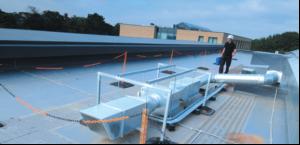John Boyle of D–Marc explains why prevention is better
than cure when it comes to protecting roof workers
The doctrine "prevention is better
than cure" is one that rings true
in so many instances. Common
sense tells John Boyle of D-Marc explains why prevention is better
than cure when it comes to protecting roof workers
The doctrine "prevention is better
than cure" is one that rings true
in so many instances. Common
sense tells us that it is much better to
prevent a fall than it is to arrest the fall
once it has occurred.
The Working at Height Regulations
(WAHR's) 2005 reinforce this argument.
While in many instances it is not
practical to remove the risk of a fall -
rainwater outlets will always require
cleaning, rooftop plant will require
regular maintenance and so on - there
are a number of ways to protect workers
from the immediate hazard the fall
presents.
In a roof work scenario the simplest
way to do this is to keep the worker away
from the fall hazard. An effective way of
achieving this which is advocated by the
WAHRs is through the provision of a
collective protection solution.
A collective protection solution is one
which will "collectively protect all those
who access the area". In a rooftop
situation where the hazard is a fall from
the roof edge, collective protection can be
achieved by raising the parapet or
through the installation of a full
perimeter guardrail.
Alternatively the worker can be kept a
safe distance from the roof edge through
the installation of a demarcation
system—Health and Safety in Roofwork
HSG 33 states that: 'Where work is not
done at the edge, demarcation barriers
can be provided at a safe distance from
the edge (usually at least 2 meters), e.g.
work on an air conditioning unit in the
middle of a roof.'
An example of the D-marc
demarcation system meeting this
requirement is a recently installed
specification at Crown Woods College,
Eltham. It provides safe access to rooftop
mounted plant where the client was
looking for a solution that would:
1. Provide a collective protection solution
2. Not penetrate the existing roof
covering and therefore not
compromise the roofs waterproofing
or air-tightness
3. Be lightweight so as not to require an
additional support structure
4. Provide easily identifiable access routes
ensuring no exposure to fall hazards
5. Be low maintenance and have good
environmental credentials.
D-marc was able to meet these criteria.
In addition, while the D-marc solutions
does not rely upon any means of
mechanical fixing to the roof structure, it
is tested to withstand wind speeds in
excess of 105 mph. Such testing is a
requirement of BS6399-2 Code of
Practice for Wind loads which states that
all components that form a building are
required to withstand a 1 in 50 year wind
speed.
D-marc was used extensively on the
project as part of the collective protection
system to create clearly defined safe
access routes across the roof for regular
maintenance work. Having created the
safe routes to the places of work, D-marc
was used to demarcate the safe working
zones upon the roof top.
To ensure a complete collective
protection solution was provided in
isolated areas where it was not possible to
keep the worker away from the fall
hazard a guardrail was used.
Systems such as the non penetrating
D-marc system create a clearly defined
access route and a safe working zone for
all those undertaking regular rooftop
maintenance works.


